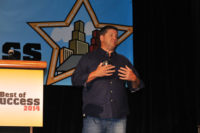Challenge
The Atlanta area’s hot, scorching summer months can be torture to just about any roofing system. The 500,000-square-foot roof on the RTG main warehouse was only seven years old when it started developing numerous blisters originating from poor installation and severe weather. The asphalt BUR membrane was drying out and showing signs of cracking and granule loss.It was estimated that it would cost RTG approximately $2.5 million in the next five years — plus the disruption associated with a complete tear-off — to replace the roof. Not surprisingly, the company’s director of facilities, Manny Delgado, began searching for an alternative to total roof replacement.
Although the roof was still carrying the original manufacturer’s warranty, preventive maintenance was not covered. As a result, preventive maintenance of the RTG roof had been neglected. A very concerned Delgado explains, “Our roof … had a history of leaks, and repairs were needed. We realized that the originally anticipated roof life was not going to be met due to the lack of a preventive maintenance program. Therefore, we needed options to extend the life of the roof.” Delgado began searching for a comprehensive roof asset management program that would reduce overall life-cycle costs while preventing a recurrence of the problems associated with neglect.
Solution
The Garland Company Inc., a Cleveland-based manufacturer of high-performance commercial roofing and building maintenance systems, was able to help Delgado. Together, Henry Passerini and Brian Sandven, roof asset management specialists for Garland, developed a proactive, quarterly, preventive maintenance program to restore the roof. The restoration included repairing the blisters, fishmouths and flashings, and applying a new reflective surface coating.According to Passerini, “We secured the owner’s trust by proving to him that dollars spent maintaining this fairly new roof now, would help to prevent premature roof failure later. If the owner had continued to neglect the roof repair and maintenance, it would end up becoming a major capital expense for RTG.”
“This project required a real team approach,” says Sandven. “We were grateful to have local contractor Pride Roofing Inc. involved from the get-go. Before they could apply our Garla-Brite™ asphalt-based protective aluminum coating over the seven-year-old cap sheet, they needed to tackle many repairs with meticulous attention to detail.”
Brad Cousins, project manager for Pride Roofing, worked with his crew from Lithonia, Ga., to orchestrate this ambitious project. He explains, “This job was very unique because of its sheer size. The roof area covered approximately 12 1/2 half acres. We made extensive repairs without a single disruption of the customer’s operations. In coating the roof, we prevented over-spray problems by using screens. We also picked roof sections to spray that would allow the wind to carry the over-spray over the roof and not over the edge to the cars below.”
Passerini reports, “Brad and his crew were great. In a job this size, it is absolutely essential that you give a critical eye to every detail. The work was done in a very professional manner so that the fleet of trucks going in and out of the facility could continue uninterrupted.”
According to Delgado, RTG expects the recent repairs and protective coating, combined with the preventive maintenance program, to extend the life of this roof 15 years or longer. He also reports that one of the most interesting results of this project has been the cooling benefits of the reflective coating. “We were very surprised to find out the before-and-after heat gain differential (25-30 F) on the actual roof. The aluminized roof coating reduced the internal heat gain throughout the warehouse. This was certainly an added bonus, not just from an energy cost savings perspective, but primarily in providing relief to our warehouse associates during hot summer days.”
Brian Sandven of Garland notes that, “Besides saving energy, the coating reduces heat-sink effects emanating off the building, helping the surrounding community. Most importantly, cool coatings also greatly slow down the aging process of the underlying roof materials, extending the roof’s service life, which lowers long-term operating costs.”
RTG is currently working with Garland to expand its proactive roof maintenance program to its other facilities. Delgado concludes, “We are extremely satisfied with both the roof product and the quality workmanship.”

Report Abusive Comment